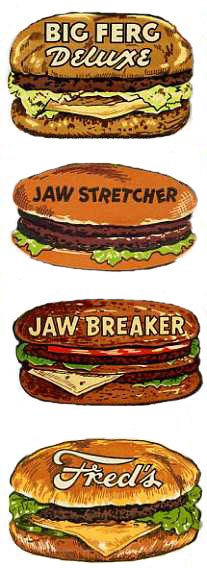 The hamburger sandwich got its start in the 1890s, probably in venues such as the night lunch wagons which were forerunners of diners. Before that, hamburger steaks (without bread) were mainly found in eating places patronized by German immigrants. Hamburger or “Hamburg” steaks were typically made of ground beef and minced onion and served with a sauce. They were such a menu staple that around 1900 black waiters in Chicago’s noisy lunch rooms created the hand signal shown here to convey orders to the kitchen. It may be a variation on the signal for “small steak” in which the fingers were raised as if taking an oath.
The hamburger sandwich got its start in the 1890s, probably in venues such as the night lunch wagons which were forerunners of diners. Before that, hamburger steaks (without bread) were mainly found in eating places patronized by German immigrants. Hamburger or “Hamburg” steaks were typically made of ground beef and minced onion and served with a sauce. They were such a menu staple that around 1900 black waiters in Chicago’s noisy lunch rooms created the hand signal shown here to convey orders to the kitchen. It may be a variation on the signal for “small steak” in which the fingers were raised as if taking an oath.
As a sandwich, the hamburger, of course, was designed to be eaten with the hands. It was a specialty of the horse-pulled lunch wagons which became widely known in Chicago at the time of the 1893 Columbian Exposition. Lacking inside seating, their customers, often nightshift workers, either took food away to eat elsewhere or consumed it standing in the street. For convenience, lunch wagons prepared every order between bread, whether it was pork chops, pigs’ feet, or eggs.
Although it provided sustenance for many, hamburger was not always considered fit food for discriminating people. It was often made from butchers’ scraps which were dosed with preservatives ranging from sulfites to formaldehyde before grinding. Doctors denounced it and in 1920 the Navy stopped buying it due to food safety concerns. All in all, hamburger’s associations with lowly lunch wagons, immigrants, the working class, spoiled meat and additives — and the smells of grease and onions — stigmatized it.
Yet somehow the hamburger on a bun survived all the attacks against it. By the late 1920s it was hailed as “the most characteristic American dish.” Because it was a thrifty meal, the Great Depression helped build its popularity. When a junior high school cafeteria in Cleveland’s Shaker Heights banned hamburgers in 1936, because “the type of young people in the Shaker Heights school are of a class that should be served a higher type of food,” the action met with negative publicity and charges of elitism.
By the mid-1950s, when suburban hamburger chains began to spread, hamburger was the “king of beef,” making inroads into New England, where roadside stands had long catered to a regional preference for hot dogs, and the South, where barbecue was a favorite. Because ground beef was well-liked, cheap year-round, and increasingly available in pre-cooked frozen patties, it became a foundational food for many restaurants.
In marketing the hamburger, proprietors have usually embraced or at least referenced its democratic unpretentiousness. In the 1920s this took the form of calling eateries shacks, hamlets, or, humorously, “castles,” while today it is evident in price appeals and representations of solidarity among diverse populations. Unless they attack on health grounds, critics of the hamburger risk being seen as culinary snobs.
© Jan Whitaker, 2008












 It's great to hear from readers and I take time to answer queries. I can't always find what you are looking for, but I do appreciate getting thank yous no matter what the outcome.
It's great to hear from readers and I take time to answer queries. I can't always find what you are looking for, but I do appreciate getting thank yous no matter what the outcome.


